The ancient Egyptian economy was a highly organized system centered on the fertile Nile and a strong centralized bureaucracy. It balanced local self-sufficiency with state planning to support monumental building projects, trade, and a complex social structure. Agriculture was the foundation, backed by taxes and labor, while religious institutions controlled vast lands and influenced both politics and economy. Manufacturing flourished in workshops, and extensive trade networks brought luxury goods from neighboring regions. Despite limited technology, Egypt’s efficient resource management and strategic governance sustained its prosperity for thousands of years, leaving a legacy of economic sophistication tied closely to religious and political power.
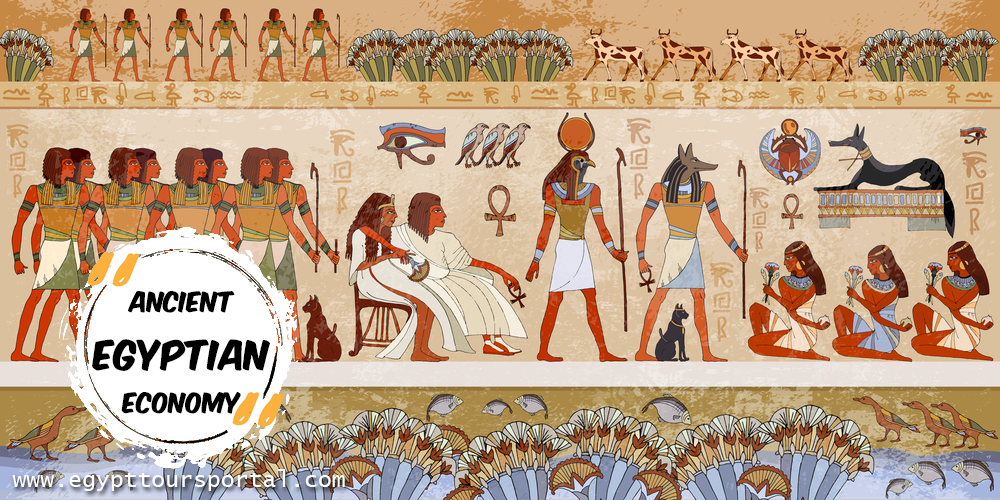
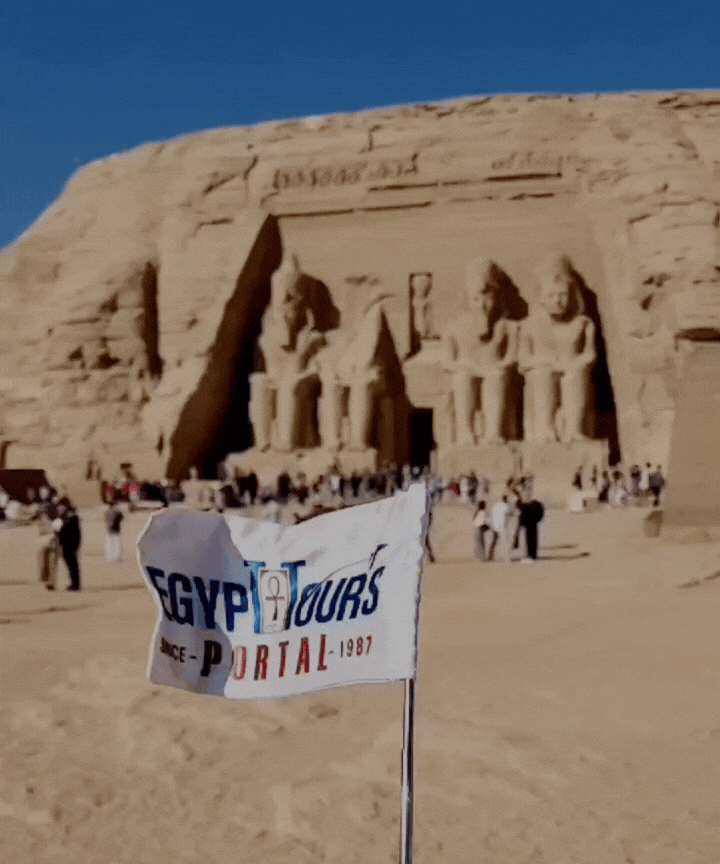
The ancient Egyptian economy was a work of perfection that led to the rise of one of the greatest civilizations in the ancient world. It was built on utilizing all the natural elements of their environment, on the concept of planned bureaucracy that monitored and controlled every single detail to absolute perfection.
The ancient Egyptian economy was a true living marvel of organization and resource management, fueling one of history's most enduring civilizations. It depended mainly upon the fertile bounty of the Nile, and it was an intricate system where centralized control met local autonomy.
Bureaucratic efficiency ensured that every aspect, from agriculture to grand public works, was meticulously planned, while local communities thrived with self-sufficiency. Massive construction projects were undertaken with a workforce that saw their labor as a sacred duty, cementing the Pharaoh's divine authority. Trade with neighboring regions brought luxury goods, thus ensuring prosperity. This blend of strategic planning and adaptability sustained Egypt's grandeur for millennia.

Egypt was mostly self-sufficient, as householders would hold many goods for the future or exchange by barter on the market, which played a key role in keeping the economy alive. The population was of a vast majority, more than nine-tenths, during the first two millennia of Ancient Egypt's history.
Ancient Egyptian Religion played a great role in shaping the minds as all the lands belonged to the ancient Egyptian gods, and like Osiris and his son Horus, the sky God after his demise, and to his earthly incarnation the pharaoh, but near the beginning of the Ptolemaic period, the land was freely bought and sold.
Most of the population were farm laborers on the estates of noble families and temples. The farmers were under a labor tax and were required to work on irrigation or certain construction projects in the form of unpaid labor. The practice of slavery was omnipresent, but it was much less harsh and was the cornerstone of the mining industry.
During Egypt new kingdom (1570-1070 BC), a third of all the lands of Egypt were in the hands of the priesthood of Amun, with a larger number of workers, and the number of foreign slaves increased with the economy. All the administrators, priests, traders, and craftsmen lived in cities along the banks of the Nile.
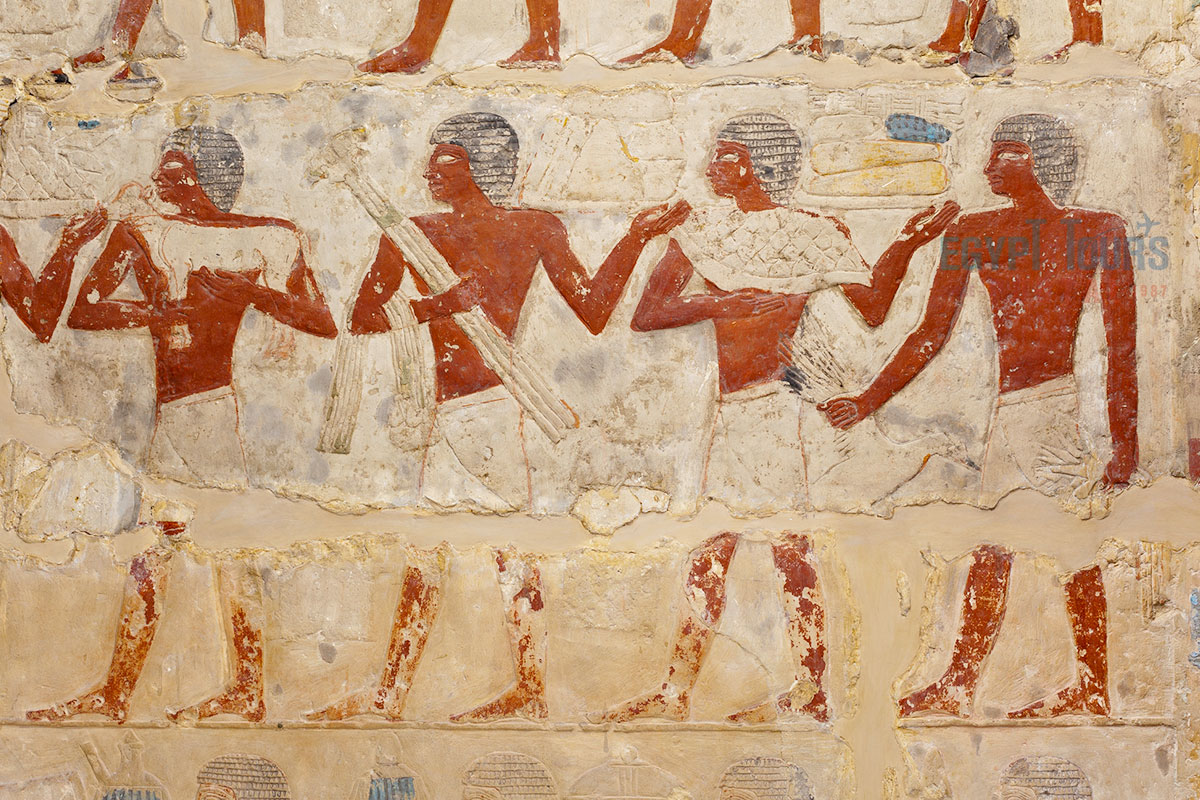
The economy of ancient Egypt functioned as a highly organized "command economy," where economic activity was directed by a centralized authority, which was principally the Pharaoh and a hierarchy of bureaucratic officials. This system enabled the pharaoh to exert control over production, taxation, and redistribution of resources, which were critical to both state projects and the daily life of ancient Egyptians. Land was reassigned annually based on the extent of flooding, with officials carefully measuring fields to assess expected yields.
Taxes were collected primarily in kind, with grain and other essential goods stockpiled in state granaries. These supplies supported laborers on monumental projects, the military, and the general public, especially during times of drought or poor harvests.
While Egypt's farmers retained a degree of independence in their daily work, they operated within a structure that prioritized the needs of the state. Much of their produce, especially surplus grain, was allocated to meet government and religious needs.
This support was key to the state’s stability, as it enabled massive construction efforts, temple offerings, and payments to workers and officials. The economy was structured to provide sustenance for a complex social order, ranging from temple priests and artisans to field laborers and soldiers.
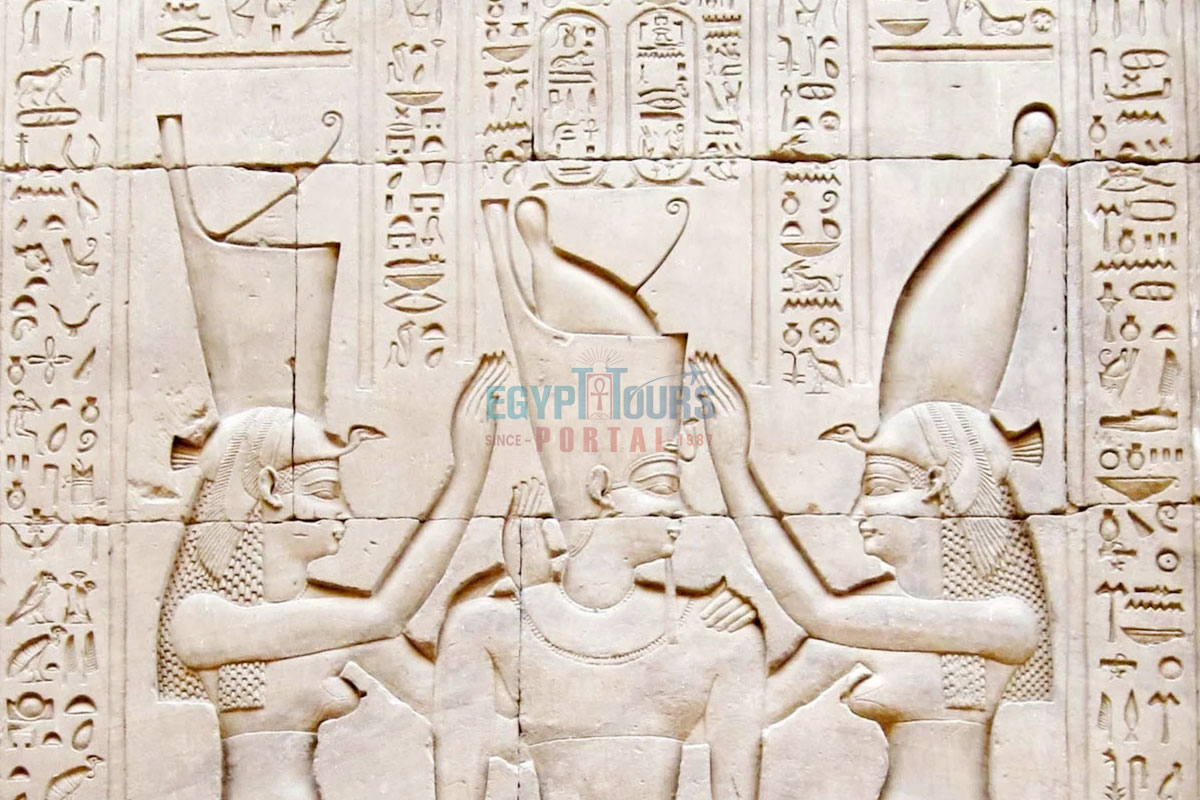
Ancient Egyptian politics and economy were deeply intertwined, with the Pharaoh positioned as both divine ruler and ultimate landowner. This concept of divine kingship imbued the pharaoh with supreme authority, while simultaneously binding Egypt’s economy to its religious beliefs. In theory, all land belonged to the gods, with the pharaoh as their earthly steward.
Practically, however, land and economic power were dispersed across a network of noble families and temple estates, each wielding influence within its domain. Noble estates, especially those held by temples, had significant autonomy but were expected to contribute to the state through taxes, labor, and services.
The Amen priesthood, particularly during the New Kingdom (1550 - 1070 BC), held immense economic power, controlling about a third of Egypt’s land. This vast resource base made the priesthood nearly as powerful as the monarchy, influencing political stability and even, at times, challenging the authority of the pharaoh.
Their wealth allowed them to support their own labor forces and projects, further contributing to the intricate balance of power that shaped the Egyptian state. This overlap of economic and political power created a system where allegiance to the pharaoh was essential but was tempered by the economic strength of the elite, who were both beneficiaries and pillars of the state. With time, the control of the trade and the overall economy of Egypt by the elite caused a severe downfall of the entire system.
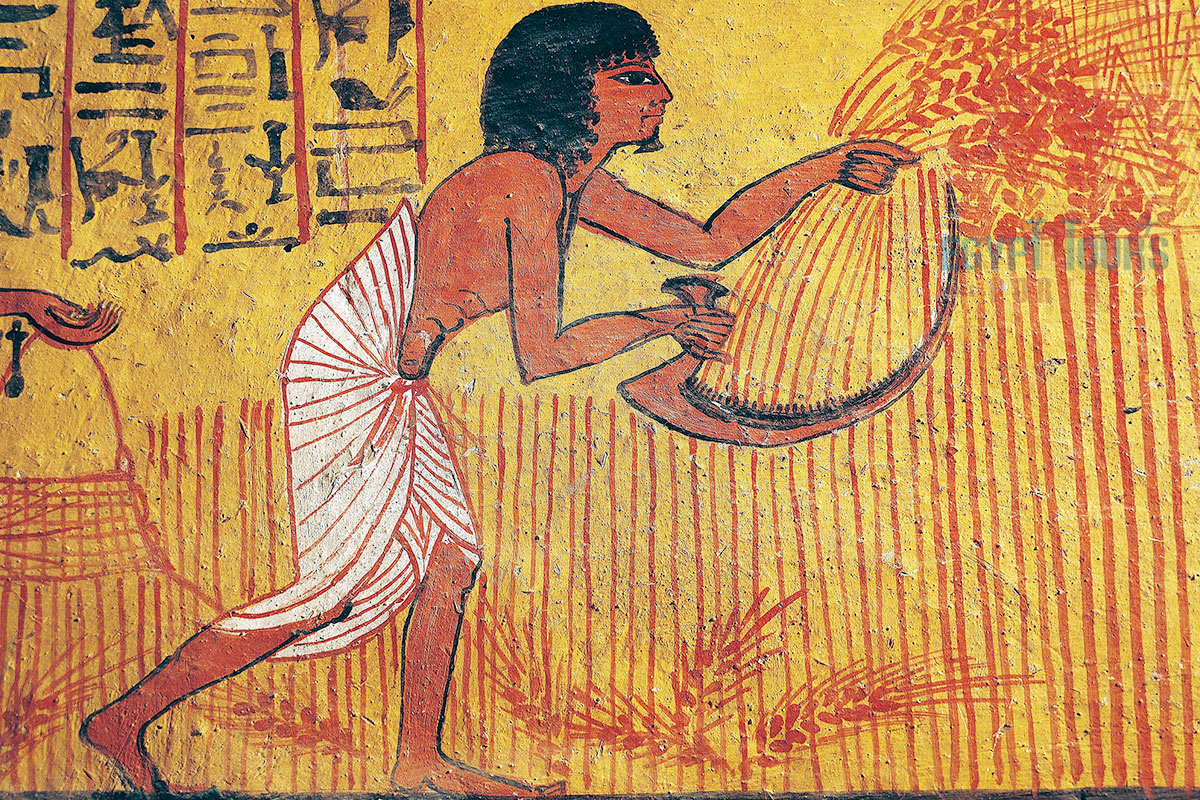
Agriculture was the main reason behind Egypt's wealth. Many grains, vegetables, fruits, cattle, and fish were harvested and gathered, and after the deduction of various taxes, the goods were sold in the market.
The Egyptian soil was very fertile due to the Nile River, but most of the agriculture techniques weren’t efficient as the implementations were primitive and improvements were rare, plus the breeding of livestock was haphazard. Pisciculture appeared to have existed in Ancient Egypt on a very small scale; all the fish were caught in the Nile, and gathering was very common among the poorest, while hunting was a leisure activity for the rich.
Discover the incredible Agriculture and Farmers of the ancient Egyptian civilization
Read More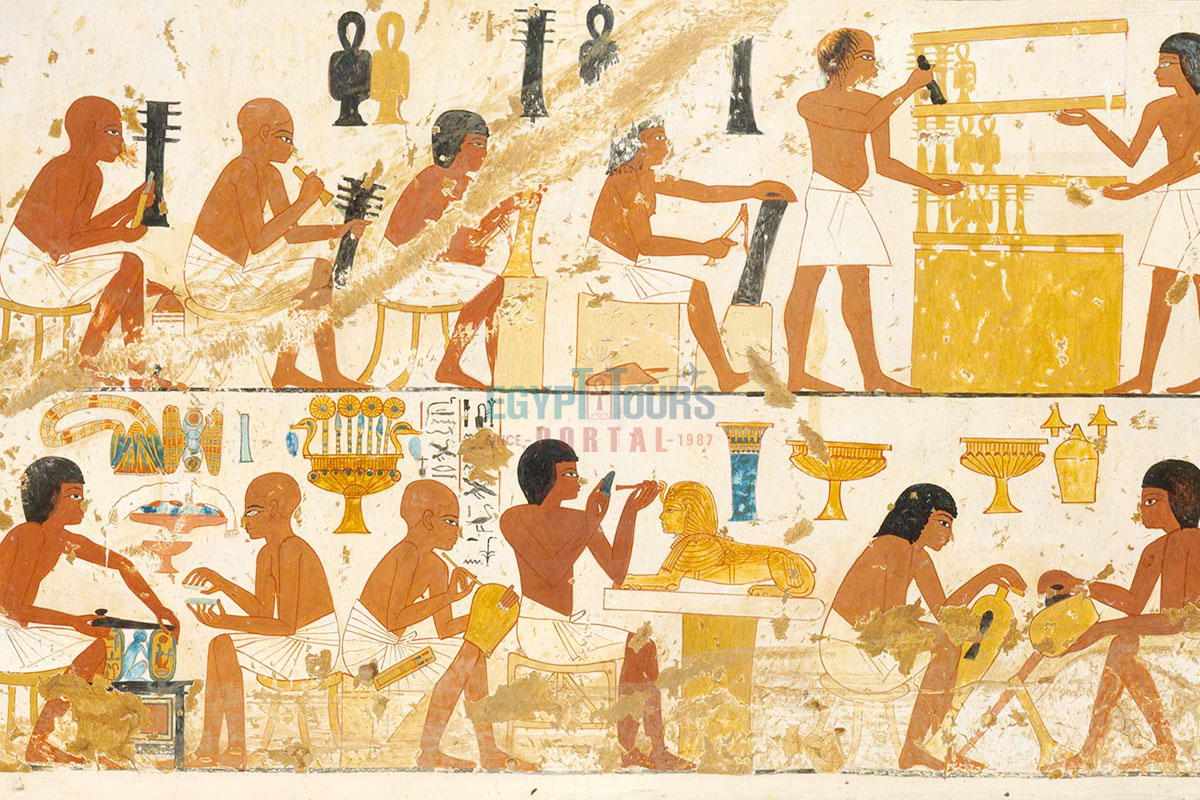
The manufacturing business was a huge part of the economic nature of Ancient Egypt. Families would produce different manufactured goods from raw materials, and the process was left to women. One of the goods was flax, which was grown by men, then the women would spin it into thread to weave linen, and the grain was used to produce beer.
The fish was caught by men, cleaned and dried by women, then sold in the market. In the towns, small factories appeared, often financed by rich noblemen, such as bakeries, breweries, carpentry workshops, and many more, with a few dozen employees.
Discover the incredible manufacturers and Jobs of the ancient Egyptian civilization
Read More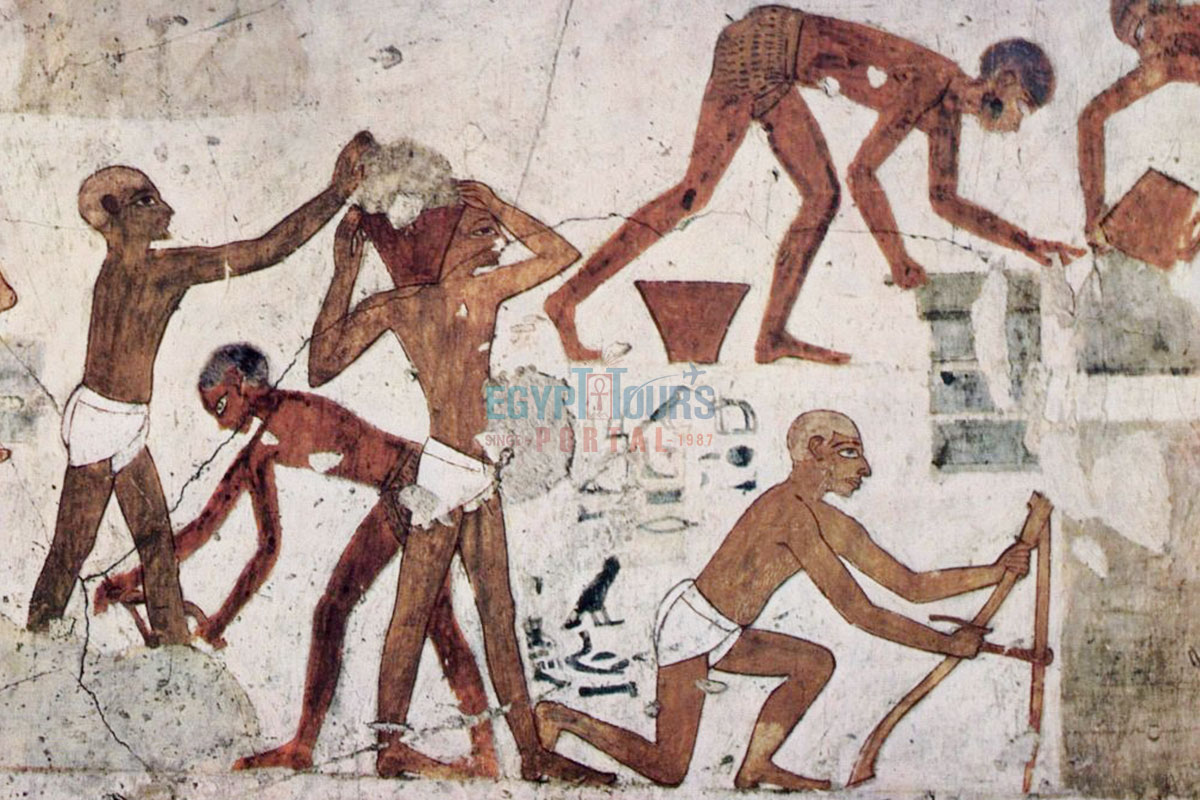
The ancient Egyptians' rich community invested a great deal of time and effort into mining, and precious metals and gems were only found in the hands of the few. The gemstones, silver, gold, metals of copper, bronze, and iron were very expensive, and any of them was only found in the hands of the wealthy and nobles of ancient Egypt, while the poor class continued to use stone and wooden tools.
The stone quarried for tombs and temples served the same all the social classes of Ancient Egypt. They also mined for Netron for thousands of years as a cleaning product for the home, the body, and for mummification as a drying agent.
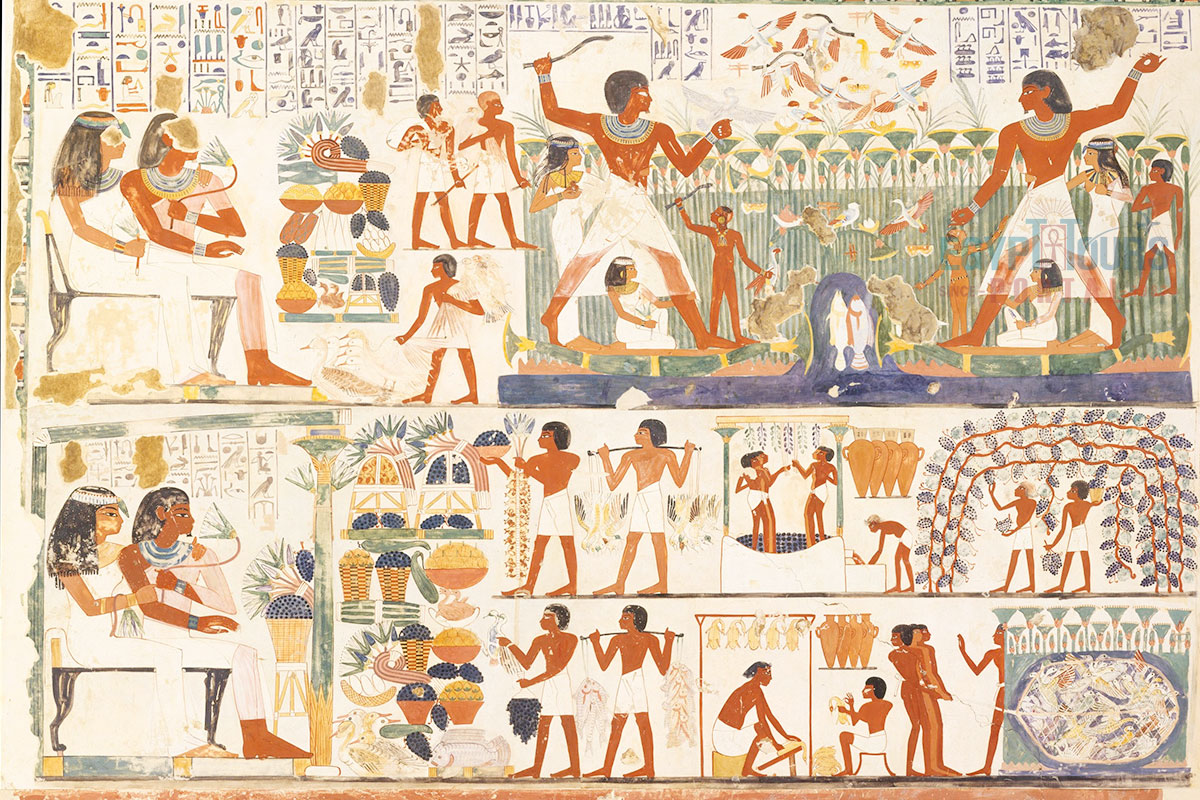
The production of farming, fishing, crafting, and mining was consumed by the producers, and after the landlords and tax-collectors took their cut, the rest was sold by barter on the market for consumers and the other professional traders who were considered to be the great estates and agents of the crown. Around 526 BC, written withdrawal orders by owners of lots of grain were used as a kind of currency, and with time, the introduction of coined money took place, but grain banks continued to serve growers and traders.
In the Ptolemaic era, the central bank of Alexandria recorded all accounts of the granary banks, and payments were transferred from one account to another. They also had credit entries that were recorded with the owner's name in a book in a passive or possessive form, while debit entries were recorded in a dative form. Materials like gold, copper, and silver were used mostly in dealing with foreign merchants and mercenaries.
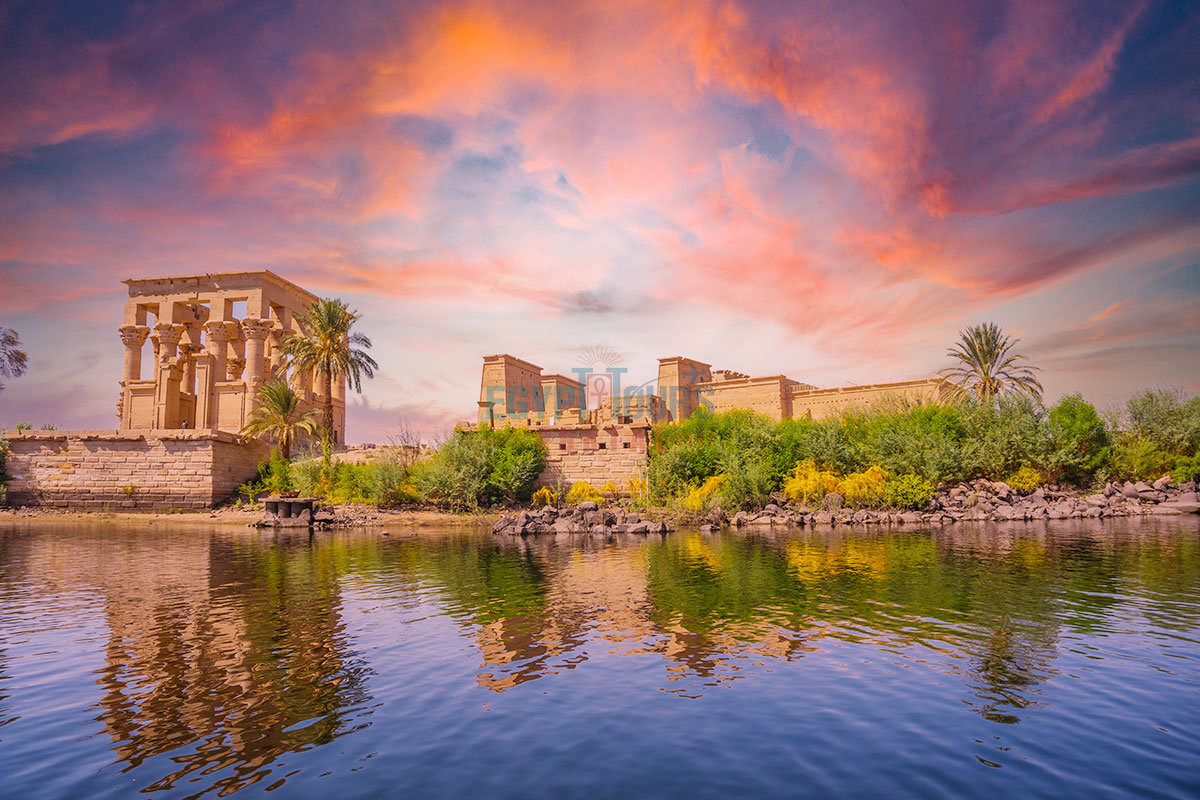
The primary source of energy in Ancient Egypt was manpower, with domestic ancient Egyptian animals playing a vital role, especially in transportation and agriculture, like donkeys and cows. Horses existed in Ancient Egypt and never held an important economic role, as they were only employed by the aristocracy and the military for riding and pulling chariots.
The usage of vehicles with light wheels came into use in the New Kingdom (15570-1070 BC). Thermal energy was also quite efficient, as the heat of the sun was very good in the production of mud bricks, the fire was used in cooking and baking food, smelting, casting metal, glassmaking, and ancient Egyptian pottery, and the fire was produced using charcoal, as coal and wood weren’t plentiful. Wind energy was used to power the ships.
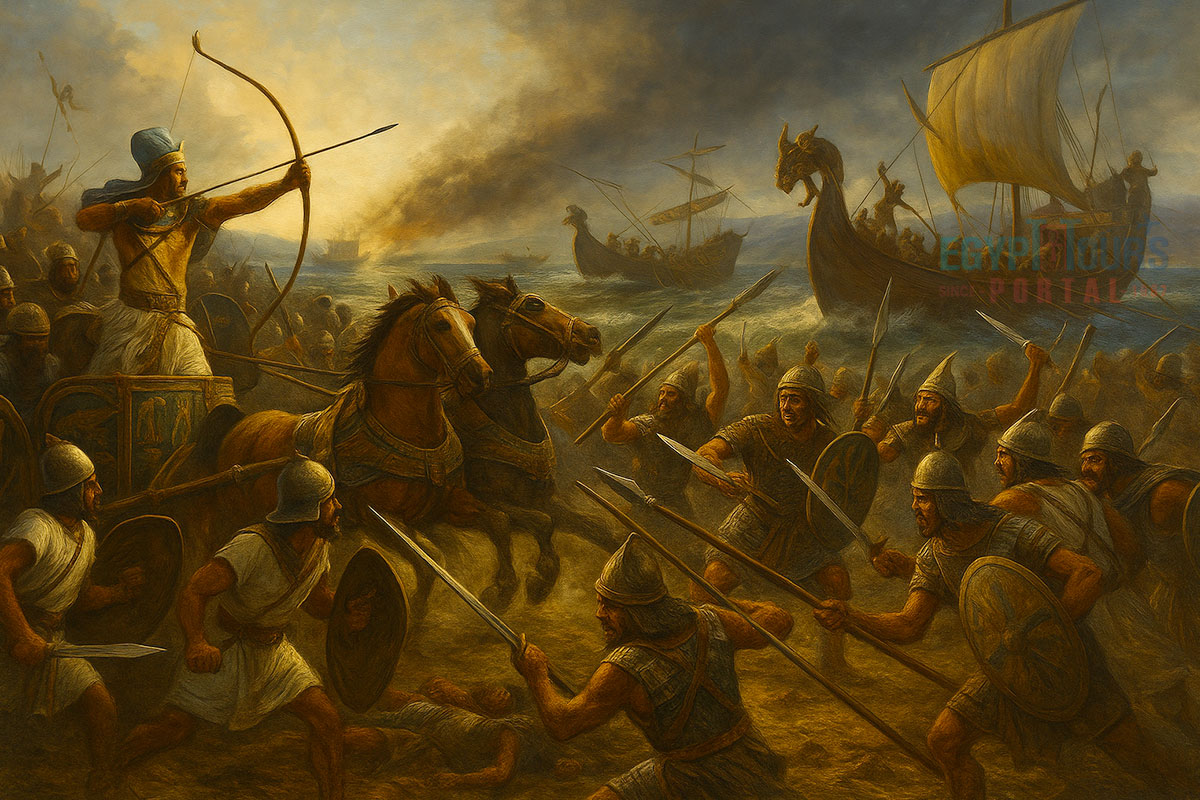
The spoils of wars were also a great source of income as long as Egypt came out victorious. Bravery in battles like the Battle of Kadesh or the Battle of Megiddo were rewarded with riches in the form of golden necklaces, bracelets, and lands as tributes were imposed on defeated nations and a sign of peace an exchange of gifts would take place between the pharaohs and the foreign kings which would always land in Egypt's favor. The ancient Egyptian civilization is one of the wealthiest cultures in history in every sense of the world.
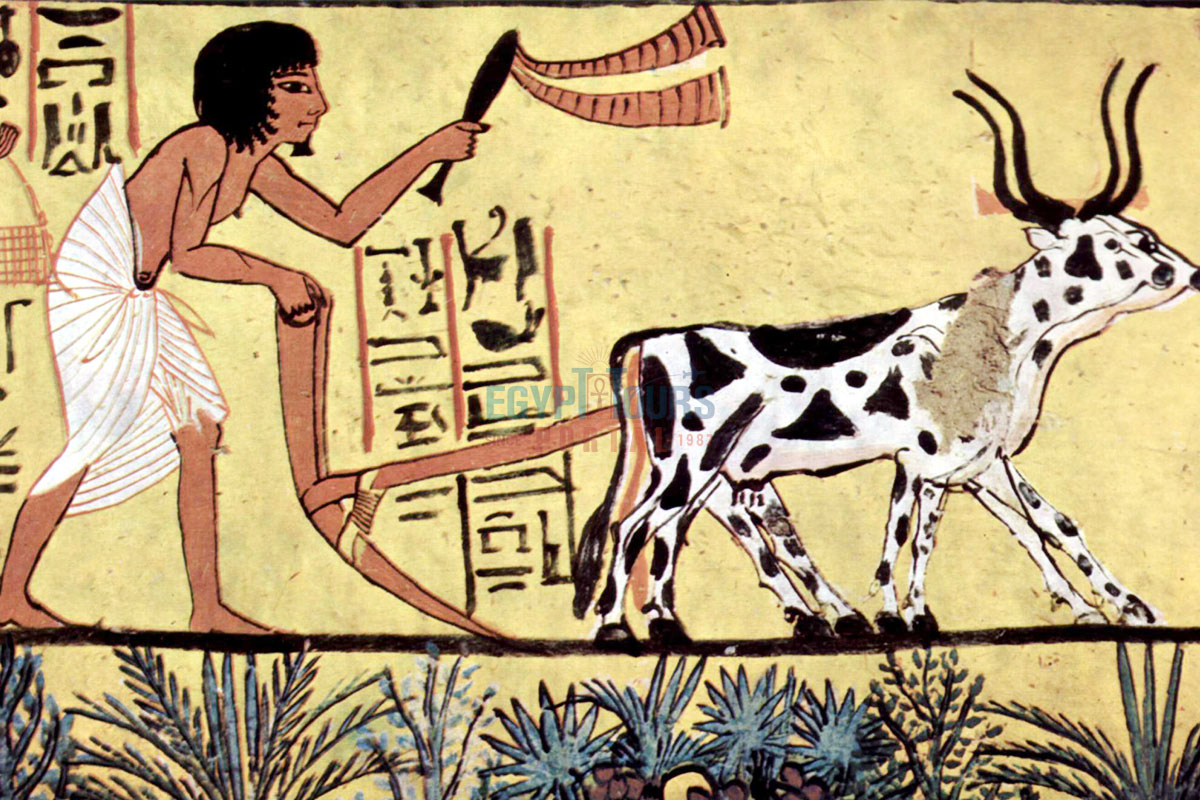
Egypt’s economic prosperity was founded on agriculture, enabled by the Nile’s predictable flooding, which provided nutrient-rich soil. Though agricultural tools remained rudimentary, the steady replenishment of fertile land supported consistent yields, enabling surpluses that could be stored or traded. Farming activities produced grains, vegetables, livestock, and more, forming the economic backbone of ancient Egyptian society and providing the most healthy ancient Egyptian foods. Fishing also played a role in Egypt’s sustenance, with the Nile’s abundant fish stocks supplementing the diet of the people.
Egypt’s economy developed through limited manufacturing, such as the production of linen, beer, pottery, and metalwork, much of which was crafted within family units or small workshops. Larger manufacturing sites emerged in urban centers, supported by wealthy patrons or state investments, and furthered the development of trades and craftsmanship.
Trade expanded significantly during the New Kingdom, linking Egypt with Nubia, Syria, and the Levant. Through these networks, Egypt acquired luxury goods and raw materials like cedar, gold, ivory, and copper. This inflow of wealth allowed Egypt to invest in religious and cultural projects, notably temples, monuments, and tombs, which, in turn, sustained jobs for artisans and laborers and showcased Egypt’s cultural legacy.
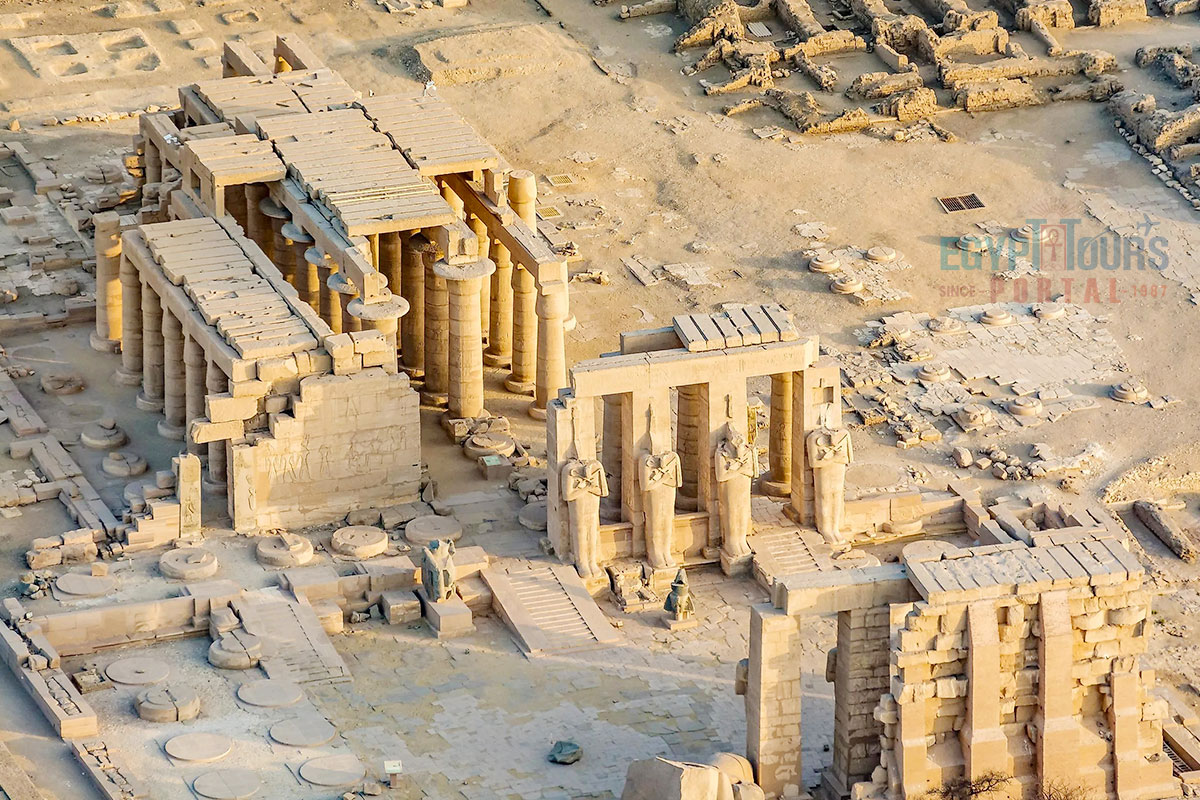
The economic structure of ancient Egypt was a complex blend of independent village communities and expansive temple estates. Villages were largely self-sufficient, with families producing their own food, clothing, and other essentials. Most trade occurred locally, with surpluses bartered in local markets, creating a patchwork of smaller, semi-autarkic economies. However, these villages operated within a larger framework that required periodic taxation, generally paid in grain or livestock, which supported the centralized economy.
At the other end of the spectrum were large temple estates, especially prominent during the New Kingdom, when temples controlled vast tracts of land and maintained dedicated workforces. Temples were exempt from taxes, allowing them to amass wealth and employ many people, including skilled artisans, farmers, and administrators.
Large-scale public works, such as the construction of temples, granaries, and workshops, were often funded by these wealthy estates or by direct state investment. This structure underscored Egypt’s social and economic hierarchy, with significant divisions between self-sustaining rural villagers and the labor forces that served the elite and religious institutions.
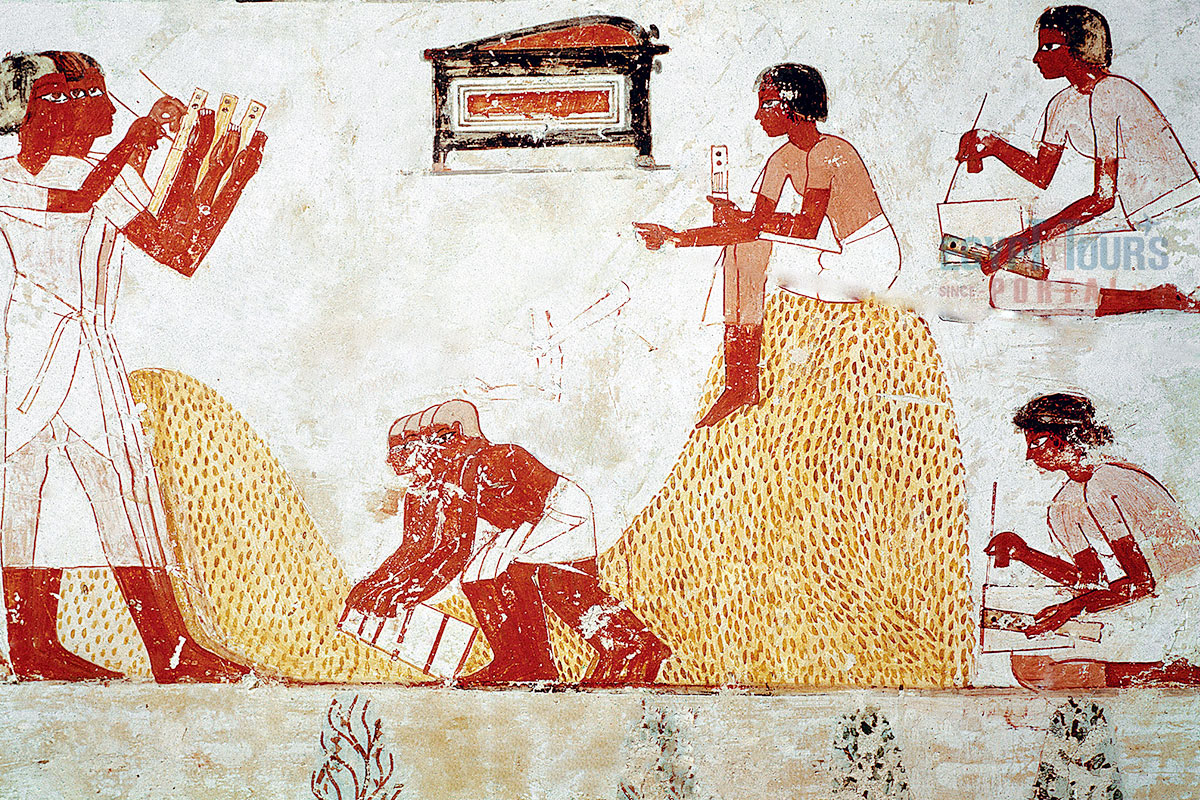
The bureaucrats were the ones in charge of public works like reassigning the land after every flooding, assessing the expected crops, collecting part of the produce as taxes, storing and redistributing, all these duties were religious and involved tens of thousands of workers and administrators.
Many elements contributed to the economy of Ancient Egypt, like the population, the management of the different sources of wealth, and the taxation system, as the nation relied on the revenues in the form of paid taxes and labor.
Grain was the main focus hoarded by the authorities, as it could be stored with relative ease and was crucial in times of bad harvests. Also, when the ancient Egyptians became more familiar with their terrain, they were able to discover trade routes between them with Arabia, Sub-Saharan Africa, the Fertile Crescent, and India.
Don't miss the chance to explore the true definition of wonder and the immortal economy of Egypt within the gates of Cairo, Luxor, and Aswan with the most charming views ever, by boarding a Nile River Cruise through our Egypt tours to explore the heavenly and colossal treasures of the ancient Egyptian civilization.
Private 4 Days Cairo Tour Packages for Irish Travelers 4 days Cairo Egypt Tour packa...
Tour Location: Cairo – Giza...
5 Days Cairo and Alexandria Tour Package For Irish Travelers 5 days Cairo and Alexan...
Tour Location: Cairo/Giza/Alexandria...
6 Days Cairo, Luxor & Aswan Tour Package For Irish Travelers 6 days Cairo, Luxor...
Tour Location: Cairo/Giza/Aswan/Luxor...
Amazing 7 Days Cairo and Hurghada Holiday for Irish Travelers 7 Days Cairo & Hur...
Tour Location: Cairo – Giza – Hurgh...
While Egypt had local markets where goods were bartered, the concept of a market economy as we understand it today did not fully apply. Much of the economy was controlled through a system of taxation and redistribution, with state officials overseeing production, distribution, and surplus storage. Localized markets existed, but they likely served a supplementary role compared to the centrally managed resources.
The Egyptian economy supported diverse jobs: farmers, fishermen, craftsmen (such as carpenters and weavers), scribes, priests, soldiers, and laborers on state or temple projects. Specific trades, like pottery, baking, or linen weaving, were prominent, especially in cities. Skilled positions, like scribes and overseers, held higher social status, while large construction projects employed thousands of workers in administrative and labor-intensive roles.
The pharaoh was the central figure in Egypt's economy, overseeing production, taxes, and the distribution of resources. A hierarchical bureaucracy managed various aspects, from agricultural assessments to the collection of taxes. Temples and the priesthood also held substantial economic power, controlling land and resources and employing a significant portion of the population for religious and economic purposes.
Trade was essential for acquiring resources not available locally, such as cedarwood, lapis lazuli, and copper. This external trade allowed Egypt to accumulate wealth and connect with foreign cultures, especially during the New Kingdom when Egyptian influence extended across the Levant and Nubia. Trade enabled Egypt to sustain its monumental construction projects, secure luxury items for the elite, and bolster its economic resilience.
Before the introduction of coined money in the Late Period, Egypt used a barter system. Wheat and grain served as a medium of exchange, and grain stored in state granaries could be traded or withdrawn through a system of written orders, functioning similarly to modern currency. Eventually, during the first millennium BCE, silver, gold, and copper coins were introduced, particularly for trade with foreign merchants.
Markets in ancient Egypt were primarily local and likely focused on bartering essential goods, though they remain poorly understood due to limited documentation. Villagers and townspeople exchanged surplus crops, livestock, and crafted goods. Larger trade exchanges occurred on behalf of the crown or temples, often involving specialized goods like pottery, linen, and foodstuffs, but individual merchants likely had limited roles in these exchanges until later periods.
The entire country of Egypt deserve to be explored with its every heavenly detail but there are places that must be seen before any other such as the breathtaking Hurghada's red sea, The wonders of Cairo the pyramids of Giza, the great sphinx, the Egyptian Museum, Khan El Khalili Bazaar, the wonders of Luxor like Valley of the Kings, Karnak & Hatshepsut temple and the wonders of Aswan such as Abu Simbel temples, Philea temple, Unfinished obelisk and The Wonders of Alexandria like Qaitbat Citadel, Pompey's Pillar and Alexandria Library. Read more about the best places to visit in Egypt.
If you want to apply for a Visa On Arrival that lasts for 30 days then you should be one of the eligible countries, have a valid passport with at least 6 months remaining and pay 25$ USD in cash, as for the E-Visa for 30 day you should have a valid passport for at least 8 months, complete the online application, pay the e-visa fee then print the e-visa to later be presented to the airport border guard. You could also be one of the lucky ones who can obtain a free visa for 90 days. Read more about Egypt travel visa.
Egypt has a variety of delicious cuisines but we recommend “Ful & Ta’meya (Fava Beans and Falafel)”, Mulukhiya, “Koshary”, a traditional Egyptian pasta dish, and Kebab & Kofta, the Egyptian traditional meat dish.
The best time to travel to Egypt is during the winter from September to April as the climate becomes a little tropical accompanied by a magical atmosphere of warm weather with a winter breeze. You will be notified in the week of your trip if the Climate is unsafe and if any changes have been made.
You should pack everything you could ever need in a small bag so you could move easily between your destinations.
We have been creating the finest vacations for more than 20 years around the most majestic destinations in Egypt. Our staff consists of the best operators, guides and drivers who dedicate all of their time & effort to make you have the perfect vacation. All of our tours are customized by Travel, Financial & Time consultants to fit your every possible need during your vacation. It doesn't go without saying that your safety and comfort are our main priority and all of our resources will be directed to provide the finest atmosphere until you return home.
You will feel safe in Egypt as the current atmosphere of the country is quite peaceful after the government took powerful measures like restructuring the entire tourist police to include all the important and tourist attractions in Egypt. Read more about is it safe to travel to Egypt.
Wear whatever feels right and comfortable. It is advised to wear something light and comfortable footwear like a closed-toe shoe to sustain the terrain of Egypt. Put on sun block during your time in Egypt in the summer to protect yourself from the sun.
The best activity is by far boarding a Nile Cruise between Luxor and Aswan or Vise Versa. Witness the beauty of Egypt from a hot balloon or a plane and try all the delicious Egyptian cuisines and drinks plus shopping in old Cairo. Explore the allure and wonders of the red sea in the magical city resorts of Egypt like Hurghada and many more by diving and snorkeling in the marine life or Hurghada. Behold the mesmerizing western desert by a safari trip under the heavenly Egyptian skies.
There are a lot of public holidays in Egypt too many to count either religious or nation, the most important festivals are the holy month of Ramadan which ends with Eid Al Fitr, Christmas and new years eve. Read more about festivals & publich holidays in Egypt.
Egypt is considered to be one of the most liberal Islamic countries but it has become a little bit conservative in the last couple of decades so it is advised to avoid showing your chest, shoulders or legs below the knees.
Arabic is the official language and Most Egyptians, who live in the cities, speak or understand English or at least some English words or phrases. Fewer Egyptians can speak French, Italian, Spanish, and German. Professional tour guides, who work in the tourism sector, are equipped to handle visitors who cannot speak Arabic and they will speak enough English and other languages to fulfill the needs of all our clients.
The fastest way is a car, of course, a taxi. If you are in Cairo ride a white taxi to move faster or you could board the fastest way of transportation in Egypt metro if the roads are in rush hour.
The temperature in Egypt ranges from 37c to 14 c. Summer in Egypt is somehow hot but sometimes it becomes cold at night and winter is cool and mild. The average of low temperatures vary from 9.5 °C in the wintertime to 23 °C in the summertime and the average high temperatures vary from 17 °C in the wintertime to 32 °C in the summertime. The temperature is moderate all along the coasts.
It is the home of everything a traveler might be looking for from amazing historical sites dating to more than 4000 years to enchanting city resorts & beaches. You will live the vacation you deserve as Egypt has everything you could possibly imagine.









